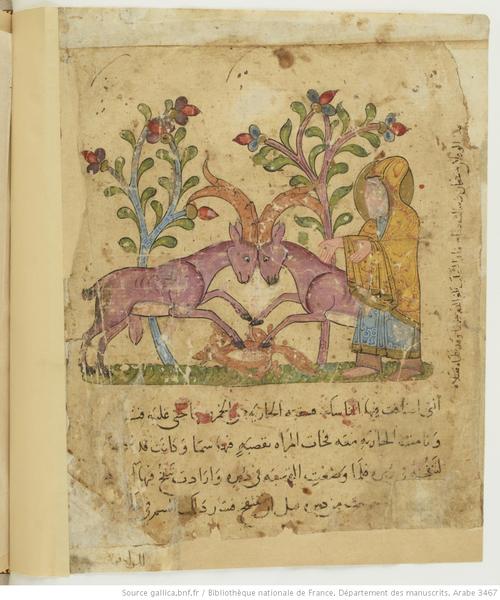The Image Cycle: How Illustrations Move across Manuscripts
Kalîla et Dimna, avec des figures coloriées.
Image Credit: Bibliothèque nationale de France, MS arabe 3467
Rima Redwan
Illustrations are an essential element in the textual history of Kalīla and Dimna; they do not only increase the material value of manuscripts, but also provide an important source of information for their date and place of production and their relation to other manuscripts.
While illustrations in manuscripts have an aesthetic value, they also show an interplay of components within a manuscript codex, often hinting at aspects that are yet unexplored. For this reason, one cannot examine the images without considering simultaneously their legends and the text’s the mise en page including the format of chapter titles and text subdivision with the aim at reconstructing each specimen’s context of production. This means, that one must consider all elements alongside each other, as their interplay gives important clues. This aspect of illustrations as a source of information for the development of the manuscript tradition has not been so far received sufficient attention.
Kalila wa Dimna is a work known both for its aesthetic dimensions and its popularity among premodern Arabic readers. It is one of few Arabic works that is often illustrated (the Maqāmat being another one), albeit with some discrepancies. While some Arabic manuscripts contain illustrations with captions, others lack the illustrations but have empty spaces reserved for them with legends that describe the content. A third variety are captions are noted within a frame in the text or in the margins, with no place left for the illustration themselves (see MS Paris BnF arabe 3473 for the first and MS Berlin Wetzstein II 672 for the second case).
An illustration imparts many kinds of information, one being evidence for dating a manuscript approximately. Illustrations further indicate relations among manuscripts. Finally, they highlight particular passages of the text.
Aside from the style of the illustrations, the depicted motifs intervene in the narrative and deserve detailed examination for the way in which they structure the plot and highlight specific scenes of frame tale and subtales. For instance, the points at which illustrations are inserted are a key aspect of each version. The resulting sequence of images in one codex, which may be termed “the image cycle,” thus becomes a factor of classification and the establishing of a timeline of all extant sequences helps ascertain in a comprehensive fashion the manuscripts’ interrelation.
One way of showing the importance of the image cycle of Kalila wa Dimna is to consider one of the oldest existing manuscripts, MS Paris BnF arabe 3465. It was created in the 13th century and comprises 98 illustrations, mostly characterized by an architectural style, except eight of them which were added at a later date. These were supplemented by another illuminator, whose work closely resembles that of MS Oxford Clarkii Or. 9. The eight illustrations added to Paris 3465 are nearly identical with those of Oxford Clarkii Or. 9. The text in Clarkii Or. 9, which has been dated to the 14th century. Moreover, the text of Oxford Clarkii Or. 9 is a verbatim twin of Paris 3465. In this case, the image cycle and the textual overlap reinforce each other in linking both manuscripts.
Another pair of manuscripts bearing similarities in image and text are the Oxford Pococke 400 and Paris BnF arabe 3467. Both manuscripts originate from Egypt or Syria in the 14th century. In style, color palette and motifs, their similarities are striking. Again, both images and text are almost identical, which means that they belong to the same image cycle. A good example is fol. 46r in Pococke 400, where the caption of the illustration is missing, and fol. 15v in Paris 3467. Both images depict a fight between two ibexes. The illustration is strongly stylized, with floral elements before a background without a frame. The animals’ representations are strikingly realistic.
In most Arabic manuscripts of Kalīla and Dimna, identical motifs recur. Von Hans Graf von Bothmer deems it probable that the illustrators used templates. This would explain the stability of these motifs over centuries.
Through exploring the manuscripts under the aspect of the image cycle, we can not only detect that many motifs were been ‘taken over,’ or duplicated but entire manuscripts were copied from each other as a complete work, retaining the same configuration of text and image. The structuring role of illustrations in this work cannot be underestimated and constitutes an important line of enquiry in the textual history of Kalīla and Dimna.
